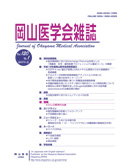

Journal of Okayama Medical Association
Published by Okayama Medical Association<Availability>
Full-text articles are available 3 years after publication.
Permalink : https://ousar.lib.okayama-u.ac.jp/17391
Studies on the bile pigment Part 2. Mass spectroscopic analysis of bilirubin Ⅸ dimethylester in various liver diseases
Izawa, Tetsuichi
Published Date
1975-06-30
Abstract
As almost no study has been made on the mass spectroscopic analysis of bilirubin obtained from the bile collected from the patients with liver diseases and Gunn rat, it was attempted to determine the isomeric composition of bilirubins by the use of mass spectrometry. Bilirubin was crystallized from the bile by Ostrow's method. Bilirubin Ⅸα dimethylester was yielded by Kuster's method from the commercial bilirubin (Daiichi pure chemical Co. Ltd.), and was purified by thin layer chromatography. Photochemical natures of the fifth of six bands was coincided with that of bilirubin Ⅸα dimethylester. The following results were obtained; 1. Mass spectra of bilirubin Ⅸα dimethylester from bilirubin Ⅸ: No molecular ions were obtained by our method. The base peak at m/e 314, 300, or 227 was found and these peaks were derived from the cleavage of central methylene bridge of bilirubin Ⅸα and Ⅸγ dimethylester. No peaks, showing the exsistence of bilirubin Ⅸβ and Ⅸδ dimethylester, appeared on the mass spectrum at m/e 360 and 239. 2. Mass spectra of bilirubin Ⅸ dimethylester from various liver diseases and from Gunn rat: Mass spectra of the bile bilirubin from various liver diseases and Gunn rat were observed at m/e 314 or 300 as the base peak and there was no significant peaks showing other isomers such as Ⅸβ or Ⅸδ dimethylester. These findings coincided with that of bilirubin Ⅸα dimethylester standard. From these results, the exsistence of other isomeric compositions except bilirubin Ⅸα (Ⅸγ) was not able to find in the bile of human being in health and various liver diseases.
ISSN
0030-1558
NCID
AN00032489
